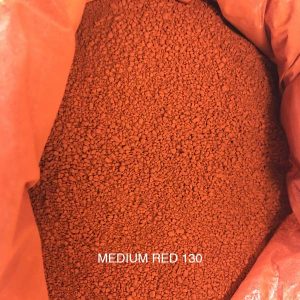Iron Oxide Pigment, Medium Red 130, Multi-Purpose
- Estimated Delivery: Urban within three days and Rural within six days.
- Free Shipping : On all orders over $300
- Returns: we accept 7-day returns, excluding genuine gold. Conditions Apply.
Medium red oxide pigment is used as dye or colourant in various applications, including ceramic, paint, concrete, coating, ink, leather, plastic and rubber. This dry pigment powder with an iron oxide base can be mixed with a binder to tint glaze and varnish or make paint.
Iron oxide is used to coat the particles in cement and mortar/plaster. You can achieve a good colour using 4% by weight of oxide to the weight of cement. At 8-10% saturation occurs and no additional benefit is achieved.
Iron-oxide mixing ratio for concrete/plaster/mortar, follow these steps:
- Determain the weight of the cement and use the table below to calculate the amount of oxide to use (based on 4%).
- Mix thotoughly with aggregate/sand and 1/2 the water. Mix thoroughly prior to adding cement and remaining water. Adequate mixing must occur to ensure full dispersion of colour.
- To achieve consistant colour ensure all batches are identical. Ideally a sample should be approved before undertaking the job.
| MIX | CEMENT | OXIDE | |
| READY MIX | 1m3 | 250kg | 10kg |
| SITE MIX | 40kg | 7kg | 280g |
| BAG CONCRETE MIX | 25kg | 3kg | 120g |
| PATCH KIT | 1kg | 300mg | 12g |
| MORTAR | 1kg | 300mg | 12g |
The above ratio is an indicative guide. Therefore, you need to determine your own mixing ratio by doing a few tests before proceeding with your job.
Pastel shades can be obtained with the light brown, reds, green and yellow by using white cement instead of grey in the mix.
Tinting strength of pigments
One brand of pigment is not the same as another. Two pigments identical in appearance may have a completely different yield. The decisive property in the use of a pigment for colouring concrete is tinting strength, which determines the depth of colour for various brands of pigment. A sample mix prepared under practical conditions can provide reliable information on this.
Natural colour of the cement and colour effect
In colouring concrete it is not the aggregate that is pigmented, rather the cement paste is coloured, which then forms a layer on the individual aggregate particles. Therefore the more the coloured cement paste is diluted with aggregate, the less intense will be the colour of the concrete.
Grey has a subduing effect on all colours, no matter where they are. Therefore, it is not possible to colour concrete made with normal grey cement as brightly as concrete containing white cement.
The gain in colour purity obtained by using white cement depends, however, on which pigment is added. In the case of black there is virtually no difference between concrete made of white cement and one made of grey cement. With dark brown, red and burnt umber the difference is small while it is considerable with yellow, marigold, green and blue.
Pigment loading and colour effect
With increasing pigment loading, the colour intensity moves towards saturation point. Adding more pigment at this point does not significantly deepen the shade and may affect the structural strength of the concrete.
The saturation point lies between approximately 5% – 8% calculated on the weight of the cement in the mix. However a good depth of colour can be achieved at 4% loading with our Oxides.
The normal ready mix concrete strength is 6 x 40kg bags of cement per cubic metre of concrete. 4% of this equates to approximately 9kg of oxide. Mortar on the other hand with its higher cement content requires more pigment. It is important to remember that pigment addition relates to the amount of cement in the mix and nothing else. A rough guide is to use approximately 1.5kg of oxide per 40kg bag of cement.
Blending of Oxides for Different Colour Shades
Oxides, like paints, can be mixed to provide a variety of colours. When mixing coloured concrete onsite, ingredients must be placed into the mixer in sequence to ensure the pigments disperse fully. With powdered colours, put pigments into the mixer along with aggregates and approximately half the required water and mix well to ensure a uniform blend: follow this by adding cement and sufficient water to obtain the desired consistency.







